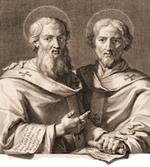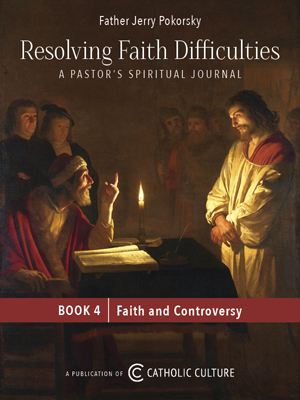Make your gift today!
Help keep Catholics around the world educated and informed.
Already donated? Log in to stop seeing these donation pop-ups.
Catholic Activity: Teaching the Trinity
Because teaching the Trinity can be a daunting task, Mary Newland explains how she taught her own children this mystery, and recommends a book on the topic for parental use.
DIRECTIONS
When a child is a little older, say four or five, and is conscious that he can "get an idea," one begins to teach more. It occurred to me, after reading Frank Sheed's explanation of the Trinity in Theology and Sanity, that one could use it in teaching children (which proves it is superbly done). Out of the love of the three divine Persons came God's idea of my children. I set out to teach my children of their beginning in the Trinity.
Literally, I said this. "Think of who you are in your own mind. Do you see yourself in your mind?" Let us say it was Christopher who nodded yes. He sees himself in his mind; he knows himself. One is always seeing one's self in one's mind. "Now say the word that is your name." "Christopher." "Christopher, as best as I can explain it, that is how it was when God the Father thought of who He was and saw Himself in His mind, and said the Word that was His name. And the one He saw was God the Son. The Father looked at the Son and loved Him so; and the Son looked at the Father and loved Him so, that their Love became another Person in God whom we call the Holy Spirit. Out of Their loving that was going on forever came the idea: I am going to make Christopher — because I want him."
Christopher does not really "get it" at four or five, but he meets it. Repeated many times during his childhood on many different occasions, prompted by various thoughts, problems, pains, joys, happinesses, it will take form and one day (it was my most recent experience to see it happen in a twelve-year-old), it will suddenly become an intellectual triumph, the first of many "now I see" experiences. Among other things, this lad saw: "In the beginning was the Word and the Word was with God, and the Word was God." This was the one who had loved him into existence. His comment was awed. "Gosh, think of all the people who don't know it, and who think that living is just a matter of getting born and living out some miserable years and dying."
In order to give his mind to this in the few minutes it takes to say it, a child must know only the names of the Persons of the Trinity (which he learns when he learns to bless himself) and that God always existed. This truth is one children often demand for themselves. Pondering their own beginning in God, children soon ask: "Who started God?" The answer is wildly difficult — or beautifully simple. For children, it is simple, not because they are up to mastering such mysteries but because their first seeing is by the black light of faith. No one started God; He always was and He always will be. How nice, says the child. When we read in the mystics of the dark journey through faith which is necessary for the soul that is led to the simplicity of union with God, we are reminded of the early years of childhood when all journeying toward God is by faith in the simplicity our Lord made a requisite for those who would enter the kingdom of heaven. We begin then to feel the urgency of this task of teaching our pre-school children about God. One must not waste their simplicity.
Activity Source: Teaching Religion at Home by Mary Reed Newland, B. Herder Book Co., St. Louis, Missouri, 1963






